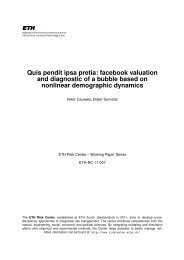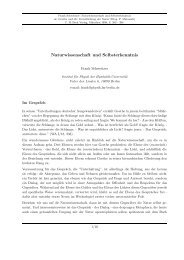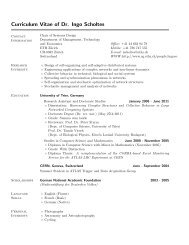Using Laboratory Experiments to Study Law and Crime - Chair of ...
Using Laboratory Experiments to Study Law and Crime - Chair of ...
Using Laboratory Experiments to Study Law and Crime - Chair of ...
Create successful ePaper yourself
Turn your PDF publications into a flip-book with our unique Google optimized e-Paper software.
shooting someone in a bar. But, given that theory predicts the results found in the surveyanalyses, legal analyses, field experiments, <strong>and</strong> labora<strong>to</strong>ry experiments, <strong>and</strong> that the results in allthese empirical settings are consistent with the theory, it would be an unlikely coincidence if themechanisms observed in the labora<strong>to</strong>ry were simply a fluke.The results <strong>of</strong> the labora<strong>to</strong>ry experiments, field experiments, <strong>and</strong> survey analyses providecomplementary evidence that support the theory. The survey analyses show that Southerners aremore supportive <strong>of</strong> some kinds <strong>of</strong> violence than Northerners. The field experiments findevidence <strong>of</strong> a causal relation between type <strong>of</strong> crime <strong>and</strong> expressions <strong>of</strong> support for those whocommit crime. The labora<strong>to</strong>ry experiments find evidence <strong>of</strong> causal relations <strong>and</strong> mechanisms.They show that insults have different physiological effects on Southerners <strong>and</strong> Northerners, <strong>and</strong>have different effects on emotional reactions <strong>and</strong> aggressive behavior. This evidence <strong>of</strong>mechanisms <strong>and</strong> causal relations in the labora<strong>to</strong>ry complements evidence from field experiments<strong>and</strong> evidence <strong>of</strong> self-reported attitudes provided by surveys. Taken <strong>to</strong>gether, these differentsources <strong>of</strong> data give us greater confidence in the theory that Southerners adhere <strong>to</strong> a culture <strong>of</strong>honor that leads them <strong>to</strong> view violence differently than Northerners <strong>and</strong> therefore reactdifferently <strong>to</strong> it. These studies do not tell us how important this cultural fac<strong>to</strong>r is in the field –how much it contributes <strong>to</strong> rates <strong>of</strong> violence relative <strong>to</strong> structural fac<strong>to</strong>rs, for example. But theyprovide evidence that the meaning <strong>of</strong> violence is different in the South than in the North <strong>and</strong> thatthis variation in meaning affects emotions <strong>and</strong> behavior. Given these results <strong>and</strong> the patterns <strong>of</strong>violence we observe in the field, it would be reasonable <strong>to</strong> conclude that cultural mechanismsexplain at least part <strong>of</strong> the variation in violence between the South <strong>and</strong> the North.PUNISHMENT SEVERITY AND CRIMEIncreasing the severity <strong>of</strong> punishment is, for some, an appealing approach <strong>to</strong> crime. Butwhile policies such as “zero <strong>to</strong>lerance” <strong>and</strong> “three strikes <strong>and</strong> you’re out” are <strong>of</strong>ten politicallypopular (Austin et al., 1999; Cohen, 1985; Hudson, 2002; Zimring, 2001), the evidence that such14







